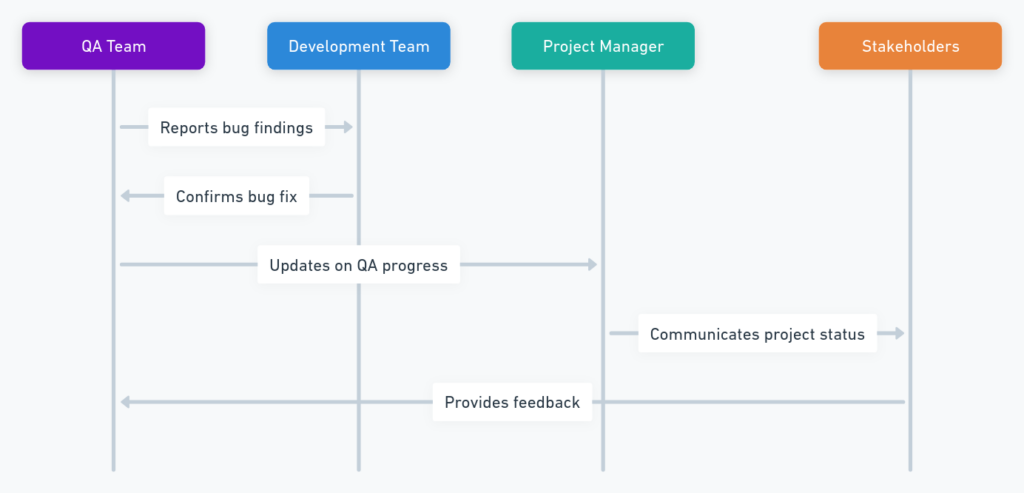Quality Assurance (QA) processes in software development cannot overstate the importance of visibility and traceability in Quality Control (QC).
These principles ensure every aspect of testing processes are observed and documented accurately, aiding decision-making and improving product quality.
Visibility and traceability in QA help teams identify issues earlier during development cycles while simultaneously increasing collaboration and communication within teams to make processes more efficient and reliable - essential elements to driving successful QA processes that ultimately yield superior products.
Importance of Visibility in QA

Visibility Is Key in Quality Assurance (QA).
Enhancing Testing Process Visibility, as it pertains to Quality Assurance (QA), refers to how obvious and visible testing processes within a project are.
Visibility in quality assurance activities means all stakeholders--be they developers, testers, project managers or clients--have clear insight into which tests are planned, conducted and their outcomes.
Openness not only helps align testing processes with business goals but also enables real-time decision-making on extensive data.
Visibility also ensures the process remains adaptable so testing teams can make necessary adjustments quickly based on updated information to increase efficiency and effectiveness of testing phases.
Facilitating Issue Identification: A Proactive Approach
With increased visibility, pinpointing bottlenecks, bugs, and performance issues is much simpler and quicker - particularly important in complex projects that involve several aspects being developed simultaneously.
When all involved have access to detailed testing data for every aspect being developed simultaneously. Issues can then be identified quickly so minor errors don't escalate into more significant setbacks.
Furthermore, visibility enables collaborative problem-solving between developers and QA professionals who can work together as necessary to address problems as they arise thereby improving overall software quality.
Significance of Traceability in Quality Assurance

Tracking Changes Efficiently
Traceability in Quality Assurance refers to the ability to trace actions, decisions, and changes back to their sources.
This ability is particularly essential in agile environments where changes happen rapidly and frequently; effective traceability ensures every change made to code is documented and linked with relevant requirements and test cases.
This comprehensive record-keeping is key to understanding their effects and assuring they improve rather than degrade product quality.
Traceability Fosters Accountability
One of the primary advantages of traceability is its ability to foster team member accountability.
By keeping detailed records of who did what and when, traceability helps pinpoint responsibility for any issues that arise and promotes a more responsible working environment as well as aiding conflict resolution and process optimization.
Accountability ensures standards remain upheld throughout a project - contributing directly to its quality at completion.
Supporting Regulatory Compliance
Traceability plays a pivotal role in meeting these regulatory standards for software development in many industries by providing an audit trail of all actions taken during project lifecycle and providing evidence of compliance checks by external auditors or compliance experts.
By showing that processes were adhered to correctly and that regulatory requirements have been fulfilled, traceability helps preserve integrity and build trust with stakeholders and regulators.
Integrating Visibility and Traceability Into Quality Assurance Processes
Tools and Technologies for Increased Visibility
Utilizing the appropriate tools and technologies is vital to increasing visibility into the quality assurance (QA) process.
Software testing tools like Selenium, JIRA, and TestRail offer robust dashboards and reporting features that enable teams to track testing progress real time.
Continuous Integration (CI) tools like Jenkins and CircleCI seamlessly incorporate testing into the deployment pipeline, making updates and results instantly visible for all stakeholders.
Dynatrace and New Relic offer insights into how software performs across environments, further increasing transparency across development lifecycle stages.
They ensure every team member can access up-to-date information about project status for improved communication and quicker decision-making processes.
Create Traceable Testing Procedures
Traceability can be achieved in testing by developing clearly documented procedures that link test cases back to their original requirements. This requires:
ReqTest and Jama Connect provide requirement management tools that facilitate direct correlations between needs and tests, so each test addresses specific requirements.
Implementing test case management tools that enable testers to efficiently record and retrieve information about test cases and their results quickly is key to providing efficient service to testers.
Leveraging version control systems like Git, which help maintain record integrity by keeping an eye on changes made to test documents and scripts over time, to maintain record integrity.
By creating traceable testing steps, teams can quickly identify which areas of an application have been fixed and which remain vulnerable - vastly increasing both the efficiency and effectiveness of testing processes.
Maintaining Visibility and Traceability in Quality Assurance: Challenges Facing Organizations
Complex Testing Environments
As testing environments become more complex, maintaining visibility and traceability becomes a greater challenge.
This challenge may arise from factors like multilayered technology stacks, multiple deployment platforms, or integration with numerous third-party services - each of which can obscure clear lines of sight in quality assurance processes and make tracking changes across systems difficult.
Modern development environments demand reliable tools and disciplined procedures in order to keep an overview of what systems are being created and tested.
Ensuring Data Integrity
Data integrity is central to maintaining traceability and visibility throughout the QA process, necessitating precise recording and updating of testing data and results.
Unfortunately, common issues like misconfigurations, human error, and software bugs can compromise data accuracy and reliability - to avoid these risks organizations must:
Implement automated tools that reduce human error and enhance data precision.
Establish rigorous access controls and audit trails to prevent unauthorized data modification and ensure all changes can be documented and traced back.
Utilize data validation protocols to constantly assess the authenticity and correctness of testing data.
By addressing these challenges, companies can strengthen their quality assurance (QA) frameworks and ensure their testing processes deliver reliable insights that lead to action.
Best Practices for Optimizing Visibility and Traceability in QA
Implement Clear Documentation Strategies
To achieve quality assurance standards, it is essential to create and keep organized documentation of each testing phase - from test plan outlines to detailed bug reports.
Documentation serves two major functions: it ensures every stakeholder can track project developments real time; and preserves historical data that could prove invaluable in future projects or audits.
Using tools like Confluence or Jira makes this process more manageable by offering platforms where documents can not only be written but shared and updated collaboratively.
Regular Reporting and Communication.
Regular reporting is key for keeping all stakeholders aware of the quality assurance process, which can be achieved with regular status meetings and updates that include all key stakeholders.
Standardized reporting templates ensure information is delivered clearly and consistently across platforms - helping minimize misunderstands while increasing transparency.
Communication shouldn't just stop at formal reports; informal check-ins between individuals also serve to keep everyone aligned and informed on recent developments and issues in the QA journey.
Continuous Monitoring and Analysis are performed continuously.
Continuous monitoring and evaluation mechanisms are integral for providing visibility and traceability in quality assurance. By tracking trends over time, these practices enable quality assurance teams to anticipate potential issues and address them proactively.
Tools like dashboards for real-time monitoring and automated testing software that logs all actions help QA teams anticipate potential issues early.
Regular evaluation meetings or peer reviews help identify areas for improvement while encouraging continuous learning among team members - these practices help organizations greatly enhance their QA outcomes.
Book a Demo and experience ContextQA testing tool in action with a complimentary, no-obligation session tailored to your business needs.
Conclusion
Visibility and traceability are central to quality assurance (QA) software testing success. Not only do these elements foster accountability and precision, they also foster an atmosphere conducive to high-quality outputs.
By adopting practices which improve these aspects:
- Teams have the capability to quickly detect and correct errors.
- Staying well-informed makes strategic decision-making simpler for stakeholders.
- Transparency and reliability have become hallmarks of success for the quality assurance process.
Organizations can ensure greater software quality through increased traceability and visibility during the testing phase, leading to higher customer satisfaction and business growth.
Also Read - What is the cost of debt?
